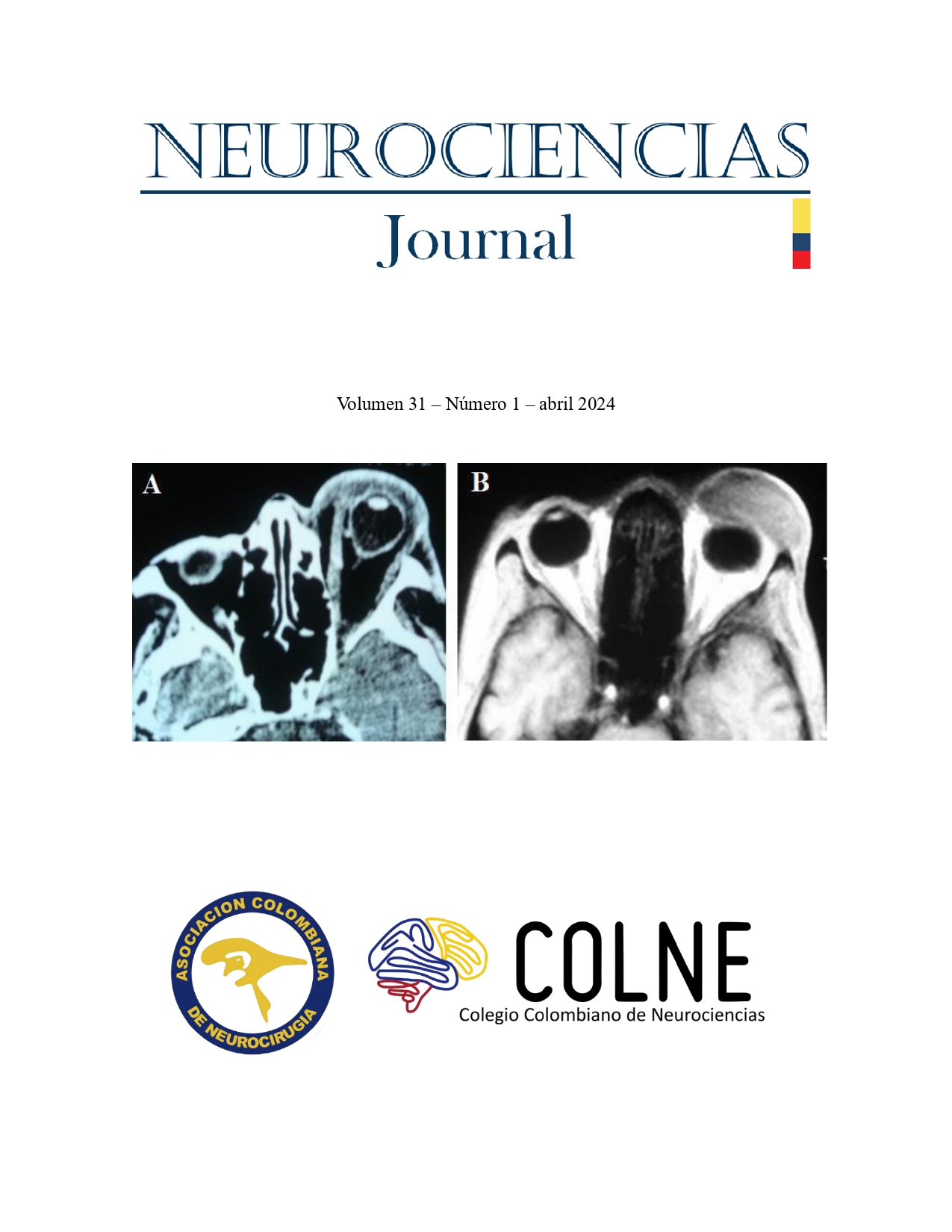Craneofaringioma adantimatoso en varón de 19 años: Un reporte de caso.
DOI:
https://doi.org/10.51437/nj.v31i1.456Keywords:
Craneofaringioma, Cefalea, HipogonadismoAbstract
Los craneofaringiomas son neoplasias benignas que afectan niños entre los 5 y los 15 años, representando hasta el 10% de las neoplasias cerebrales infantiles. Aunque se consideran malignidades de bajo grado, su crecimiento puede comprimir estructuras adyacentes, causando síntomas neurológicos, endocrinos y visuales.
Presentamos el caso de un varón de 19 años que experimentó diplopía y hemianopsia bitemporal durante aproximadamente 3 años. Durante la exploración física, se observó escaso desarrollo puberal, poco vello facial, voz aguda, leve lipomastia, obesidad troncular e hipogonadismo. Los estudios de neuroimagen revelaron la presencia de un craneofaringioma de aspecto quístico y bilobulado. En junta de neurocirugía, se decidió realizar una resección utilizando un abordaje pterional transilviano.
Tras la cirugía, en la unidad de cuidados intensivos, el paciente desarrolló diabetes insípida que requirió vasopresina. Además, presentó hipopituitarismo, que se trató con corticoides y levotiroxina para suplir el déficit del eje corticotrópico y tirotrópico.Es crucial considerar los craneofaringiomas como parte del diagnóstico diferencial en pacientes con alteraciones en la agudeza visual, diplopía y cefalea crónica. Esto permitirá prevenir la aparición de alteraciones neuroendocrinas y del desarrollo puberal. Se sospecha que la lesión pudo afectar a periodos sensibles de hormonas como la luteinizante y la testosterona, lo que explica las manifestaciones observadas en el paciente.
References
Müller HL, Merchant TE, Warmuth-Metz M, Martinez-Barbera J-P, Puget S. Craniopharyngioma. Nat Rev Dis Prim 2019;5(1):75. Available from: https://doi.org/10.1038/s41572-019-0125-9
Zhou Z, Zhang S, Hu F. Endocrine Disorder in Patients With Craniopharyngioma. Front Neurol. 2021;12 (December):1–11. Available from: https://doi.org/10.3389/fneur.2021.737743
Mende KC, Pantel TF, Flitsch J. Revived Attention for Adult Craniopharyngioma. Exp Clin Endocrinol Diabetes 2021 Mar 1;129(03):172–7. Available from: http://www.thiemeconnect.com/products/ejournals/html/10.1055/a-1217-7282
Khan RB, Merchant TE, Boop FA, Sanford RA, Ledet D, Onar-Thomas A, et al. Headaches in children with craniopharyngioma. J Child Neurol 2013;28(12):1622–5. Available from: https://pubmed.ncbi.nlm.nih.gov/23143722/
Hölsken A, Sill M, Merkle J, Schweizer L, Buchfelder M, Flitsch J, et al. Adamantinomatous and papillary craniopharyngiomas are characterized by distinct epigenomic as well as mutational and transcriptomic profiles. Acta Neuropathol Commun 2016 Feb 29;4:20. Available from: /pmc/articles/PMC4770705/
Hölsken A, Buchfelder M, Fahlbusch R, Blümcke I, Buslei R. Tumour cell migration in adamantinomatous craniopharyngiomas is promoted by activated Wnt-signalling. Acta Neuropathol 2010 May;119(5):631–9. Available from: https://pubmed.ncbi.nlm.nih.gov/20131060/
Zhao C, Wang Y, Liu H, Qi X, Zhou Z, Wang X, et al. Molecular biological features of cyst wall of adamantinomatous craniopharyngioma. Sci Rep 2023;13(1):3049. Available from: https://doi.org/10.1038/s41598-023-29664-z
Cabrera Bernal E. Craneofaringioma en pediatría: diagnóstico y tratamiento. Rev Colomb Hematol y Oncol 2020 Aug 1;7(2 SE-Revisiones):64–74. Available from: https://revista.acho.info/index.php/acho/article/view/112
Kiliç M, Can SM, Özdemir B, Tanik C. Management of Craniopharyngioma. J Craniofac Surg 2019;30(2). Available from: https://journals.lww.com/jcraniofacialsurgery/fulltext/2019/03000/management_of_craniopharyngioma.110.aspx
Prieto R, Barrios L, Pascual JM. Papillary Craniopharyngioma: A Type of Tumor Primarily Impairing the Hypothalamus – A Comprehensive Anatomo-Clinical Characterization of 350 Well-Described Cases. Neuroendocrinology 2022 Sep 20;112(10):941–65. Available from: https://dx.doi.org/10.1159/000521652
Sowithayasakul P, Beckhaus J, Boekhoff S, Friedrich C, Calaminus G, Müller HL. Vision-related quality of life in patients with childhood-onset craniopharyngioma. Sci Rep 2023;13(1):19599. Available from: https://doi.org/10.1038/s41598-023-46532-y
Huang CC, Lin KL, Wu CT, Jung SM, Wang CJ, Chen YC, et al. Clinical and endocrinological manifestations of childhood-onset craniopharyngioma before surgical removal: A report from one medical center in Taiwan. Pediatr Neonatol. 2021 Mar 1;62(2):181–6. https://doi.org/10.1016/j.pedneo.2020.08.014
Momin AA, Recinos MA, Cioffi G, Patil N, Soni P, Almeida JP, et al. Descriptive epidemiology of craniopharyngiomas in the United States. Pituitary 2021 Aug 1;24(4):517–22. Available from: https://link.springer.com/article/10.1007/s11102-021-01127-6
Frič R, König M, Due-Tønnessen BJ, Ramm-Pettersen J, Berg-Johnsen J. Long-term outcome of patients treated for craniopharyngioma: a single center experience. Br J Neurosurg. 2023; https://doi.org/10.1080/02688697.2023.2179600
d’Avella E, Vitulli F, Berardinelli J, Cinalli G, Solari D, Cappabianca P, et al. Systematic review of transcranial and endoscopic endonasal approaches for craniopharyngiomas in children: is there an evolution? J Neurosurg Pediatr 2024;33(1):73–84. Available from: https://thejns.org/pediatrics/view/journals/j-neurosurg-pediatr/33/1/article-p73.xml
Jazbinšek S, Kolenc D, Bošnjak R, Faganel Kotnik B, Zadravec Zaletel L, Jenko Bizjan B, et al. Prevalence of Endocrine and Metabolic Comorbidities in a National Cohort of Patients with Craniopharyngioma. Horm Res Paediatr 2020 Jul 3;93(1):46–57. Available from: https://doi.org/10.1159/000507702
Qi ST, Peng JX, Pan J, Fan J, Zhang SC, Liu Y, et al. Hypopituitarism mode in patients with craniopharyngioma in relation to tumor growth pattern. Zhonghua Yi Xue Za Zhi. 2018 Jan;98(1):19–24. DOI: 10.3760/cma.j.issn.0376-2491.2018.01.005
Bidur Devkota KP. Outcome following surgical resection of craniopharyngiomas: A case series. Asian J Neurosurg 2017;12(03):514–8. Available from: http://www.thiemeconnect.com/products/ejournals/abstract/10.4103/1793-5482.150228


